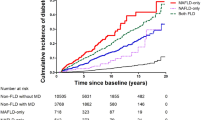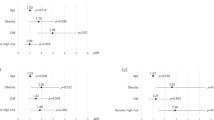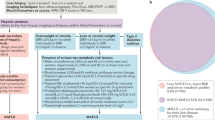Abstract
Severe obesity (body mass index ⩾35 kg m−2) and type 2 diabetes (T2D) are potent and additive risk factors for non-alcoholic fatty liver disease (NAFLD), including non-alcoholic steatohepatitis (NASH). Scant available evidence indicates that black relative to white patients with severe obesity are less susceptible to NAFLD, but it is unclear if T2D abolishes this apparent racial disparity. Therefore, we compared biopsy-proven NAFLD and its progression between black (n=71) and white (n=155) patients with severe obesity stratified by presence or absence of T2D. Although prevalence of T2D was similar between races (37%, P>0.9), whites were significantly more likely than blacks to have NAFLD, NASH and advanced fibrosis (defined as bridging fibrosis and/or cirrhosis). Importantly, T2D was associated with increased odds of NAFLD, NASH and advanced fibrosis (defined as bridging fibrosis or cirrhosis) in whites only (P<0.05). In turn, a higher proportion of blacks than whites with T2D were free of NAFLD (58 versus 22%, P<0.01). These preliminary findings question translation of the powerful interconnection between T2D and NAFLD in whites with severe obesity to blacks and point to an important role of race in the pathophysiology and treatment of these diseases.
This is a preview of subscription content, access via your institution
Access options
Subscribe to this journal
Receive 12 print issues and online access
$259.00 per year
only $21.58 per issue
Buy this article
- Purchase on Springer Link
- Instant access to full article PDF
Prices may be subject to local taxes which are calculated during checkout
Similar content being viewed by others
References
Flegal KM, Carroll MD, Kuczmarski RJ, Johnson CL . Overweight and obesity in the United States: prevalence and trends, 1960–1994. Int J Obes Relat Metab Disord 1998; 22: 39–47.
Ogden CL, Carroll MD, Kit BK, Flegal KM . Prevalence of childhood and adult obesity in the United States, 2011–2012. JAMA 2014; 311: 806–814.
Gregg EW, Cheng YJ, Narayan KM, Thompson TJ, Williamson DF . The relative contributions of different levels of overweight and obesity to the increased prevalence of diabetes in the United States: 1976–2004. Prev Med 2007; 45: 348–352.
Ganz ML, Wintfeld N, Li Q, Alas V, Langer J, Hammer M . The association of body mass index with the risk of type 2 diabetes: a case-control study nested in an electronic health records system in the United States. Diabetol Metab Syndr 2014; 6: 50.
Lazo M, Hernaez R, Eberhardt MS, Bonekamp S, Kamel I, Guallar E et al. Prevalence of nonalcoholic fatty liver disease in the United States: the Third National Health and Nutrition Examination Survey, 1988–1994. Am J Epidemiol 2013; 178: 38–45.
Machado M, Marques-Vidal P, Cortez-Pinto H . Hepatic histology in obese patients undergoing bariatric surgery. J Hepatol 2006; 45: 600–606.
Wong RJ, Aguilar M, Cheung R, Perumpail RB, Harrison SA, Younossi ZM et al. Nonalcoholic steatohepatitis is the second leading etiology of liver disease among adults awaiting liver transplantation in the United States. Gastroenterology 2015; 148: 547–555.
Beymer C, Kowdley KV, Larson A, Edmonson P, Dellinger EP, Flum DR . Prevalence and predictors of asymptomatic liver disease in patients undergoing gastric bypass surgery. Arch Surg 2003; 138: 1240–1244.
Anstee QM, Targher G, Day CP . Progression of NAFLD to diabetes mellitus, cardiovascular disease or cirrhosis. Nat Rev Gastroenterol Hepatol 2013; 10: 330–344.
Campos GM, Bambha K, Vittinghoff E, Rabl C, Posselt AM, Ciovica R et al. A clinical scoring system for predicting nonalcoholic steatohepatitis in morbidly obese patients. Hepatology 2008; 47: 1916–1923.
Solga SF, Clark JM, Alkhuraishi AR, Torbenson M, Tabesh A, Schweitzer M et al. Race and comorbid factors predict nonalcoholic fatty liver disease histopathology in severely obese patients. Surg Obes Relat Dis 2005; 1: 6–11.
Kallwitz ER, Guzman G, TenCate V, Vitello J, Layden-Almer J, Berkes J et al. The histologic spectrum of liver disease in African-American, non-Hispanic white, and Hispanic obesity surgery patients. Am J Gastroenterol 2009; 104: 64–69.
NIH conference. Gastrointestinal surgery for severe obesity. Consensus Development Conference Panel. Ann Intern Med 1991; 115: 956–961.
Sanyal AJ, Brunt EM, Kleiner DE, Kowdley KV, Chalasani N, Lavine JE et al. Endpoints and clinical trial design for nonalcoholic steatohepatitis. Hepatology 2011; 54: 344–353.
Kleiner DE, Brunt EM, Van Natta M, Behling C, Contos MJ, Cummings OW et al. Design and validation of a histological scoring system for nonalcoholic fatty liver disease. Hepatology 2005; 41: 1313–1321.
Bril F, Cusi K . Management of nonalcoholic fatty liver disease in patients with type 2 diabetes: a call to action. Diabetes Care 2017; 40: 419–430.
Menke A, Casagrande S, Geiss L, Cowie CC . Prevalence of and trends in diabetes among adults in the United States, 1988–2012. JAMA 2015; 314: 1021–1029.
Goedecke JH, Keswell D, Weinreich C, Fan J, Hauksson J, Victor H et al. Ethnic differences in hepatic and systemic insulin sensitivity and their associated determinants in obese black and white South African women. Diabetologia 2015; 58: 2647–2652.
Albu JB, Kovera AJ, Allen L, Wainwright M, Berk E, Raja-Khan N et al. Independent association of insulin resistance with larger amounts of intermuscular adipose tissue and a greater acute insulin response to glucose in African American than in white nondiabetic women. Am J Clin Nutr 2005; 82: 1210–1217.
Ellis AC, Alvarez JA, Granger WM, Ovalle F, Gower BA . Ethnic differences in glucose disposal, hepatic insulin sensitivity, and endogenous glucose production among African American and European American women. Metabolism 2012; 61: 634–640.
Author information
Authors and Affiliations
Corresponding author
Ethics declarations
Competing interests
The authors declare no conflict of interest.
Rights and permissions
About this article
Cite this article
Browning, M., Khoraki, J., DeAntonio, J. et al. Protective effect of black relative to white race against non-alcoholic fatty liver disease in patients with severe obesity, independent of type 2 diabetes. Int J Obes 42, 926–929 (2018). https://doi.org/10.1038/ijo.2017.309
Received:
Revised:
Accepted:
Published:
Issue Date:
DOI: https://doi.org/10.1038/ijo.2017.309
This article is cited by
-
Limitations of Noninvasive Tests-Based Population-Level Risk Stratification Strategy for Nonalcoholic Fatty Liver Disease
Digestive Diseases and Sciences (2024)
-
High-Risk Groups for Non-alcoholic Fatty Liver and Non-alcoholic Steatohepatitis Development and Progression
Current Hepatology Reports (2020)
-
Population Diversity Challenge the External Validity of the European Randomized Controlled Trials Comparing Laparoscopic Gastric Bypass and Sleeve Gastrectomy
Obesity Surgery (2020)
-
Prevalence and long-term outcomes of non-alcoholic fatty liver disease among elderly individuals from the United States
BMC Gastroenterology (2019)
-
Ethnic Disparities in Adiposity: Focus on Non-alcoholic Fatty Liver Disease, Visceral, and Generalized Obesity
Current Obesity Reports (2019)



